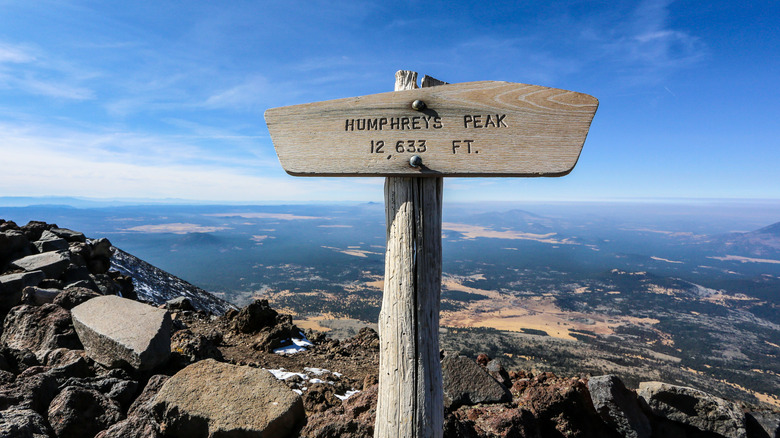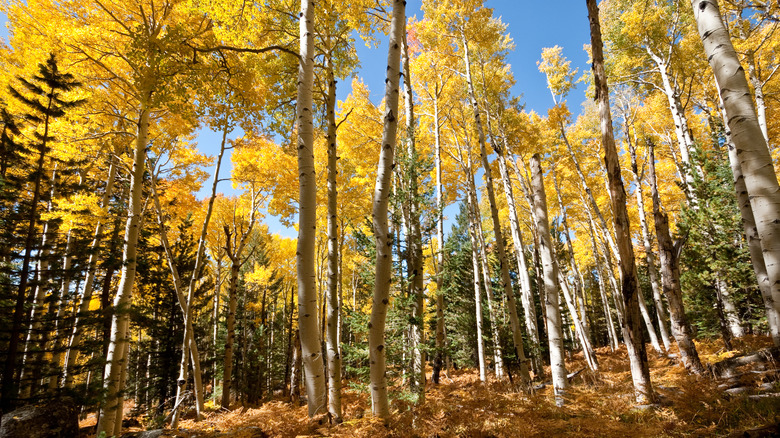Just Outside Flagstaff Is A High-Altitude Forest With Lava Fields, Icy Trails, And Stunning Summit Views
While for many, Arizona conjures up desert-themed images of red rocks, the Grand Canyon State also has one of the world's largest continuous ponderosa pine forests, the Coconino National Forest. In contrast to the rest of the state, Flagstaff, the snowiest mountain town in America, is surrounded by high-altitude forests. As a part of the Coconino National Forest, the Kachina Peaks Wilderness, less than 25 minutes from the city, is a favorite day-trip destination for those in Flagstaff and Phoenix. It's famed for housing the 12,643-foot Humphreys Peak, the tallest summit in Arizona that's part of a group of dormant volcanoes known as the San Francisco Peaks.
Open year-round, the Kachina Peaks Wilderness has something for everyone, depending on the season. Ski bunnies can swish down the slopes in the winter or embark on a cross-country skiing journey on an icy trail. Hikers can cool off on a handful of trails in shady forests with high elevations and cooler temperatures in the summer months, while plant lovers can enjoy the sights of blooming wildflowers in the spring, changing leaves in the autumn, and flora endemic only to this particular part of Arizona. Because the wilderness is part of the San Francisco Peaks, hiking the Kachina Peaks Wilderness will bring you across lava fields, down volcanic cliffs, and alongside andesite boulders pushed along by an ancient eruption 600,000 years ago.
High altitudes and volcanic remnants on the Kachina Peaks trails
The Kachina Peaks Wilderness is named for the Hopi gods that live in these dormant volcanoes, who come down in mid-summer in the form of clouds to bring rain to the land. This area remains sacred today, as seen by the shrines scattered around the wilderness, which should be left undisturbed. These include dendroglyphs, or tree carvings, made by Basque shepherds in the 1880s and 1920s. While various communities have engaged with the Kachina Peaks in different ways, these days, the best way to do so is by hiking one of the area's high-altitude trails, which are perfect whether you're embarking on your first solo hike or going with a group.
The Kachina Trail starts at about 9,300 feet and covers 10.4 miles (out-and-back), winding through ponderosa pines, Douglas firs, and quaking aspens — which get their names from the breezes that make them shake. It also crosses an ancient lava flow from the era when this area was filled with active volcanoes. One of the more popular trails is Humphreys Peak, a 9.5-mile out-and-back path that takes you to the highest point in Arizona, where you can see the Grand Canyon and Painted Desert on a clear day. This trek brings you to one of Arizona's only alpine environments, where you can find the San Francisco groundsel, a low-lying plant that's endemic to these mountains and doesn't grow anywhere else in the world. For this reason, be sure to stay on the marked path, and keep an eye out for exposed tree roots around the Kachina Peaks Wilderness, as they can make you lose your footing.
What to know when visiting Kachina Peaks Wilderness
Kachina Peaks Wilderness is open year-round, but it's especially popular in the summertime, since its higher altitude and shaded paths offer a necessary respite from Arizona's scorching desert temperatures. Consider going either super early or on a weekday to beat the crowds, and be prepared for traffic, especially if coming from Phoenix. While the closest airport in Flagstaff is just 30 minutes away, the Phoenix airport is at least 3.5 hours away, making this a viable (but hefty) day-trip from Arizona's capital. The most convenient way to get to Kachina Peaks Wilderness is to drive up to Snowbowl, the starting point for most of the area's trails. If you're interested in getting the best views without hiking, you can take a summertime scenic gondola that rises above the San Francisco Peaks and offers incredible panoramic vistas. At this time, entrance to the wilderness is free.
Because of the higher altitude of Kachina Peaks Wilderness, it's possible to experience altitude sickness in this location. Symptoms can include nausea and dizziness, so be sure to stay very hydrated, take frequent breaks, and consider staying in Flagstaff the night before your visit to let your body acclimate to the higher elevation, which are some of the best things to do to prevent altitude sickness. It's also recommended to download the trail maps beforehand since the path isn't always clear or visible. The length of some of the hikes has been affected by wildfires, as previously short ones, like the 3.3.-mile, out-and-back Inner Basin Trail, has had several miles added to it due to fires in 2024, so it's best to double-check updates before heading out.


